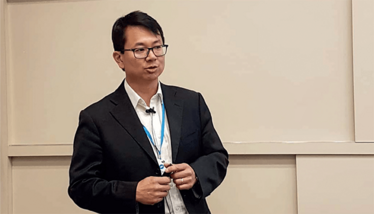Legislating Meaningful Change
Sitting Down With… Kowid Ho, Head of International Technical Regulatory Policy at Roche
Maryam Mahdi | | 5 min read | Interview

Reviewing, revising, and analyzing drug submissions is par for the course for Kowid Ho, Head of International Technical Regulatory Policy at Roche. Although he is now an industry veteran, his journey into the pharma industry has been far from linear. Here, he shares how he found his first regulatory role in industry, his proudest achievements, and his thoughts on the trends set to take the sector by storm.
How did you first get involved with pharma?
I didn’t plan to pursue a career in pharma. I actually wanted to be a researcher. I studied pharmacy at a university in France and had my sights set on a completely different professional path – but I stumbled across an opportunity to work at a French medicines regulatory agency and ended up working there for 13 years, even though it was nothing I had ever intended to do! Nevertheless, it was an experience I thoroughly enjoyed.
Through the agency, I became involved in several committees – but a reshuffle within the organization prompted me to move on and see what was happening in the industry. Though I had worked closely with pharma companies, I had never had a role within one before. I ended up joining Roche and have been pretty happy with the nine years of experience I’ve amassed since then. It has taught me a lot about the inner workings of the pharma sector.
Why is the biopharmaceutical industry so inspiring to you?
Before joining pharma, I was concerned by what some might call the “dark side of the industry.” In other words, I was worried that companies would prioritize financial gain above all else. But I was surprised to find how patient-centric the industry was. When I joined Roche nine years ago, I wouldn’t have been able to imagine the number of conversations I have had about the future of patient care.
The attitude that I have encountered among my colleagues and peers has been incredibly inspiring. My current role also pushes me to think about the ways a given medicine could impact patient lives. It’s evident that a patient-first mindset permeates all aspects of the industry and helps drive progress in the field.
What have been your proudest achievements?
Around 2004, my team and I had a challenging time when it came to biosimilars. The European Commission wanted us to draft some guidance on their quality requirements, but we had a limited timeframe in which to do so. Despite the pressure, we managed to meet our deadline and the guidance was finally published in 2006. Many of the concepts outlined in the document are still used today on an international scale! It was a massive personal achievement and, in spite of the challenges, something I look back on with a sense of fondness.
I’ve also had the pleasure of working with the WHO. In fact, working alongside the organization has been one of the most gratifying and rewarding experiences of my professional life. The WHO’s efforts to support patients in need – wherever they might be – really bring you back to earth. The opportunity I’ve had to collaborate with them has reminded me that some of the challenges I often face within the pharmaceutical sphere are luxuries for most people around the world, who, at the end of the day, are looking for the simplest, most cost-effective methods to treat the diseases they live with.
What industry trends are you focused on?
A lot of my work focuses on the evolution of regulatory frameworks across the world. Currently, ATMP field is rapidly growing; as a result, we’re seeing a lot of different guidance popping up. Although it’s positive that so many people are interested in these products, monitoring the legislation that is developed is quite complicated. With the number of texts that are now being published, we are now at risk of divergence in terms of requirements and fundamental expectations when it comes to the quality standards and the classification of these products.
If you could create a wishlist of policies, what would it include?
There are two key elements. One would be the harmonization of technical requirements for R&D. The other would be reliance between healthcare authorities.
With regard to harmonization, there are increasing discrepancies between some regions. For example, in the EU or US regions there is a wealth of technical guidances for product development that have been published but, when we look farther afield, many countries in the world are developing their own regulation and technical guidance that introduces differences in the way products are registered. If we could develop agreements that help align these regulatory frameworks, we would see a difference in the ways companies approach product development and registration. Some industry groups are working toward this type of harmonization, but although organizations like WHO and ICH are attempting to drive convergence in that field, the broad range of topics they have to address and the limited experience mean that this won’t happen quickly.
Beyond this, I would love to see greater collaboration between all the stakeholders, including regulators, academics and industries. If people shared their experiences and challenges, we could mutually learn from each other and build a better framework to enable patient access to innovative medicines.
On what pharmaceutical frontiers are you most excited to see progress?
Two of the biggest areas of innovation I’ve noticed in recent years are the technological evolution that has happened in the gene therapy space and the use of big data and artificial intelligence platforms. We’re seeing the convergence of these two things more than ever before. When you develop gene therapies using AI tools, you end up with therapies that are so advanced it’s difficult to catch up. It’s also a challenge to develop appropriate regulations for this kind of fast-paced therapy development where there is a need to find a proper balance to properly enable innovation without over-regulating the field.
But this is an incredibly interesting area for regulatory professionals to contend with. The future will undoubtedly have hurdles for us to address, but I’m incredibly excited by the prospect of making a difference in this area.
After finishing my degree, I envisioned a career in science communications. However, life took an unexpected turn and I ended up teaching abroad. Though the experience was amazing and I learned a great deal from it, I jumped at the opportunity to work for Texere. I'm excited to see where this new journey takes me!



















